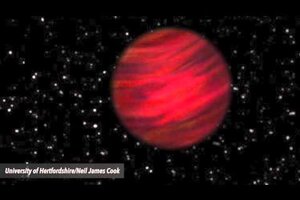This weird solar system is the widest ever discovered
Scientists have confirmed the discovery of the widest known solar system - 600 billion miles across. While its existence is unusual, the bigger question is how it got there.

A planet thought to be a lone celestial wolf traveling through space without a star has turned out to be part of the largest solar system known to science.
Scientists have discovered two formerly unassociated astronomical bodies, a lone planet and a star billions of miles away from each other, are in the longest long-distance relationship found so far.
The planet, 2MASS j2126-8140, and its star, TYC 9486-927-1, were both discovered in the last decade and thought to be unrelated. A new study, published in Monthly Notices of the Royal Astronomical Society, shows that the distant objects are linked in a massive orbit. The connection makes the two the lone occupants of the widest known solar system.
2MASS j2126-8140 is roughly 600 billion miles away from TYC 9486-927-1 and completes an orbit about every 900,000 years, according to the press release for the study. Its distance in astronomical units is 6,900 or almost seven thousand times the distance from Earth to the Sun and dwarfs the distance of even the proposed Planet Nine, an icy planet drifting around in the darkness of our own solar system, to the Sun (600-1,200 au).
While the extreme distance between this planet and its star is the furthest orbit yet discovered, scientists say they can explain how the solar system continues to exist and survive using their current understanding of the universe.
“It’s not a stretch of the imagination to say this is a bound system. It’s very unlikely that it would be splitting apart,” Dr. Niall Deacon, lead author of the study and research fellow at the University of Hertfordshire's Centre for Astrophysics Research, says in a phone interview.
The part of space where the 2MASS j2126-8140 and its star exists is not an unusual portion of the universe. It is known as the Solar neighborhood and the same area of the galaxy the Sun is located in. The gravitational pull of the primary star, TYC 9486-927-1, will continue to keep the planet in orbit indefinitely, unless disturbed by an external event or force.
“It’s not so much a question of can it survive there. It’s a question of how it got there,” Mr. Deacon says.
There are two primary theories surrounding how 2MASS j2126-8149 arrived at a location so far from its sun, according to Deacon. It likely either formed on its own from a collapse of gas far away from its star or it could have formed closer and been pushed farther away by another body. Scientists don't agree on how it was formed.
2MASS j2126-8140 is very similar to another planet, beta Pictoris b, which was one of the first planets directly imaged in another solar system, according to the press release for the study. The two share similar mass, age, and temperature, but, puzzlingly for scientists, the two are drastically different distances from their suns.
"Compared to beta Pictoris b, 2MASS J2126 is more than 700 times further away from its host star," Dr. Simon Murphy of the Australian National University, also a study co-author, said in the press release.
The recent findings of the widest known solar system are “not going to discover aliens or work out exactly why the universe started the way it did or anything like that,” Deacon says. “It shows that the universe is a very, very diverse and unusual place and that there are things that don’t always look like the solar system we have. Any theories of how planets form have to start to explain all the various diverse range of planets and systems that we find around other stars, and this is an extreme one…”

